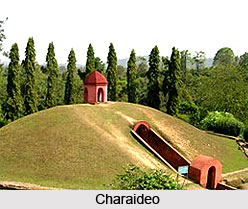 Purandar Singha was the last king of Ahom dynasty and was coronated twice as the king. Firstly he reigned from 1818 to 1819 A.D. while later he once again ruled the kingdom from 1833 to 1838 A.D. He was installed on the throne for the first time by Ruchinath Burhagohain by disposing Chandrakanta Singha. Later he was given the administration by the British authorities who sensed the discontent among the local folks owing to the foreign rule and installed Purandar Singha on the throne.
Purandar Singha was the last king of Ahom dynasty and was coronated twice as the king. Firstly he reigned from 1818 to 1819 A.D. while later he once again ruled the kingdom from 1833 to 1838 A.D. He was installed on the throne for the first time by Ruchinath Burhagohain by disposing Chandrakanta Singha. Later he was given the administration by the British authorities who sensed the discontent among the local folks owing to the foreign rule and installed Purandar Singha on the throne.
First Coronation of Purandar Singha
Purandar Singha was the son of Brajanath Gohain and great grandson of Swargadeo Rajeswar Singha. Previously he lived in Silmari with his father and grandfather. After their unsuccessful attempts of becoming the Ahom king, they were sent to exile. Early life of Purandar Singha was spent in economic hardships. He was firstly installed as the king of Ahom kingdom by Ruchinath Burhagohain in 1818 AD after disposing the former king Chandrakanta Singha from the throne. Since at the time of coronation Purandar Singha was quite young, the actual authority of the throne remained with Ruchinath Burhagohain and Brajanath Gohain who immediately removed all the nobles from the office who were suspected to bear loyalty for the former king.
End of the First Reign of Purandar Singha
After the coronation of Purandar Singha, Badan Chandra Borphukan who was the former Ahom viceroy of Ahom kingdom went to the Burmese monarch Bodawpaya to plead for help. Owing to an alliance with Chandrakanta Singha, Burmese monarch immediately sent an army under the commandership of Kiamingi Borgohain. The Ahom army initially resisted the attack successfully but later were later defeated. Purandar Singha along with his father and Ruchinath Burhagohain retreated to Guwahati along with all the valuables from royal treasury. The Burmese then reinstalled Chandrakanta Singha on the throne and proceeded to capture Guwahati. This forced Purandar Singha and Ruchinath Burhagohain to escape to Bengal where they appealed the British Governor-General Lord Hastings for helping them in the recovery of Ahom kingdom.
Second Coronation of Purandar Singha
The First Anglo-Burmese War commenced in 1824 A.D. which led to the defeat of Burmese followed by their expulsion from Assam. Later, on 26 February 1826 the treaty of Yandabo was signed between the British and the Burmese to end the war in which the former gained the possession of the Brahmaputra valley. After the occupation of Assam by the British, several members of Ahom dynasty appealed to the government for the restoration of Ahom rule in the region. Initially the British authorities ignored the appeals but later with time a discontent grew among the local people of Assam due to the foreign rule. Some of the members of Ahom dynasty even conspired against the British rule but were unfortunately caught and punished. However the dissatisfaction continued to amplify and thus in 1832 A.D. the British rulers decided to restore Ahom rule in Upper Assam. The two most eligible candidates for the throne at that time were Chandrakanta Singha and Purandar Singha. After a thoughtful phase, the British government finally selected Purandar Singha as the able king.
Second Reign of Purandar Singha
Purandar Singha was made the in charge of Upper Assam in April 1833 and Jorhat became the capital of the kingdom. He appointed many officers as per the Ahom system of governance, but as the Ahom territory reduced as compared to his earlier reign, many of the posts were left vacant. The economy of the kingdom also depleted for which the payment to the officials became difficult. Maniram Dewan, one of the officials had prominent powers in the kingdom and monitored the administration and revenue collection of the state. However within the period of three years Ahom kingdom faced severe economic setbacks and many a time failed to pay the revenue to the British Government which led to the instability in kingdom administration. Owing to the failure of Purandar Singha as a king, the kingdom was once again brought under the British control in September 1838 A.D. Thus the British East India Company disposed the king and annexed Upper Assam with their territories extending their authority all over Assam. This put an end to the 600 years of Ahom rule in Assam.
Death of Purandar Singha
After being expelled from the throne Purandar Singha spent the rest of his life in Jorhat with his family. He died on October 1st 1846 just before the Durga Puja celebrations. His body was buried in a Maidam built in Jorhat. The place is currently is known as Raja Maidam situated in Jorhat town.



















